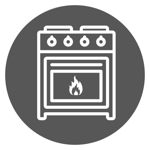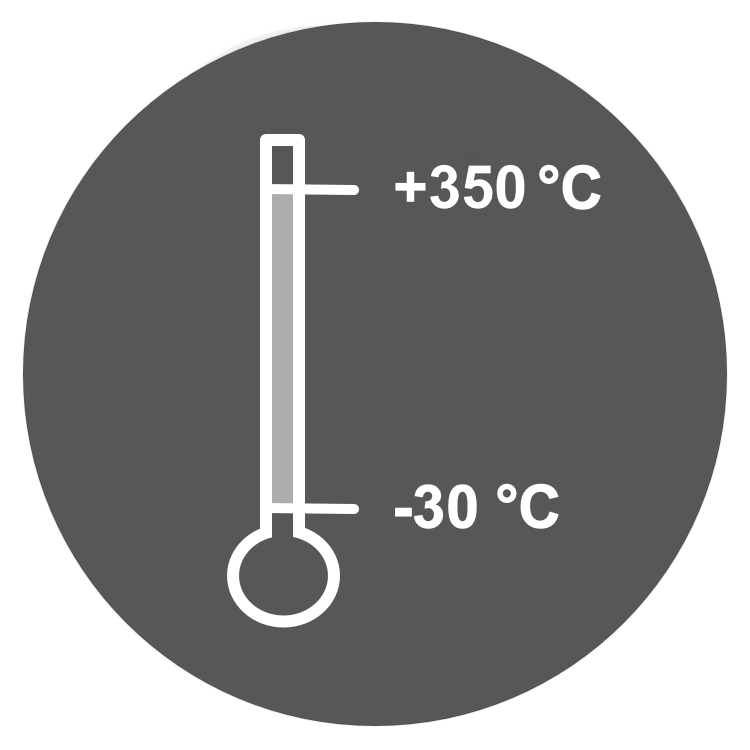Thermal shock
Thermal shock resistance & oven resistance
 |  |  |
Definition of thermal shock
In the natural sciences, thermal shock is defined as a rapid, shock-like change in the temperature of a material or workpiece. A thermal load caused by thermal shock leads to mechanical stresses between the outer and inner parts of a body, as the heat or cold is transferred to the surface faster than to the inner core. If the resulting mechanical stresses exceed the critical value of the respective material, internal or external damage occurs.
Thermal shock of porcelain and ceramic crockery
Porcelain, like the majority of ceramic tableware, consists of a body (inner core) and a glaze that encloses the body. The thermal expansion coefficients of these two components of a piece of crockery are always different and vary in strength. Material density and the type of glaze are decisive for the sensitivity of the coefficient of expansion. The following rule applies: the higher the final hard firing, the more homogeneous the glass phase in the vitrification process. In other words, the higher the firing, the smaller the difference between the expansion coefficients of the body and glaze.
As a rule of thumb, the higher a ceramic material is fired, the lower the risk of breakage due to thermal shock.
How does thermal shock occur in porcelain?
There are many ways to induce thermal shock on crockery. This can occur from hot to cold and vice versa from cold to hot. This usually happens in the kitchen. However, kettles and coffee machines can also cause thermal shock to cups and mugs when hot drinks are poured into them. Thermal shock therefore always occurs when hot food or drinks come into contact with a colder piece of crockery - or vice versa. Placing porcelain on hot surfaces such as hot plates and heat-retaining systems can also lead to thermal shock. To avoid describing everything twice, please read the paragraph "How to avoid thermal shock" below.
Is thermal shock specifically defined?
No. There is no DIN standard or other binding definition that specifies the thermal shock of porcelain or other ceramic crockery as a differential value for an indicated change in temperature. This is based on too many different types of material and possibilities. Not only are there major differences between porcelain and ceramic, but the raw material composition, material thickness, density, porosity and the type of glaze also have a decisive influence on the thermal shock sensitivity of the respective piece of crockery. However, experience has taught us that low-fired ceramics can suffer thermal shock even at a thermal load of around 40 °C or more. Good hard porcelain in hotel quality, on the other hand, should survive around 50 °C without any problems.
What happens in the event of thermal shock?
The effects of thermal shock vary greatly. In the worst case, the crockery item breaks immediately and any liquids or food spills out.
Crackling or craquelure cracks, which are also often referred to as "silent thermal shock", are less noticeable. Stoneware, earthenware and other low-fired types of ceramic are susceptible to craquelure cracks, which are particularly noticeable in coloured drinking cups. As the stress cracks between the glaze and the body are already damaged, breakage does not usually occur here, but such cracks are not only unsightly but also unhygienic.
Far more dangerous and always a cause of irritation are fine hairline cracks as a result of thermal shock, which do not immediately cause the crockery item to break. Depending on the consistency of the fragment, the piece can be used several more times without anything happening. On the table or in the cupboard, as if by magic, it finally breaks. Under the weight of a pile of crockery, it often makes a loud "bang" sound. As the damage occurred days or weeks before the actual breakage, many consumers then categorise such damage as a manufacturing defect.
How can thermal shock be avoided?
Porcelain and all other types of ceramic crockery have intended use properties. A conventional (cheap) ceramic pizza plate is designed to serve a pizza on the table. It is not made for placing in a charcoal oven. With self-critical judgement and careful use, many causes of damage due to thermal shock can be avoided.
- Never pour hot food and drinks into cold porcelain.
- Preheat porcelain before serving, e.g. in crockery stackers or warming cabinets.
- Heat hollow parts such as cans and bowls with hot water.
- Never transfer chilled crockery from the cold store or refrigerator to hot heat sources.
- Never place food together with porcelain in a blast freezer or freezer compartment.
- Avoid placing hot crockery items, e.g. baking tins, on cold surfaces such as marble worktops or stainless steel work surfaces.
- Never quench hot crockery under cold water.
- Use a Tourchon (pit towel) or a heat protection grid when setting down hot crockery items.
- Only heat powerful heat sources, e.g. a salamander, slowly together with the porcelain.
- Avoid localised heat radiation such as that generated by a gas flame.
Is thermal shock resistant porcelain available?
Yes, there is both thermal shock-resistant porcelain and thermal shock-resistant ceramic. These types of crockery are even suitable for direct regeneration of food.
The qualities Alumina porcelain, High Alumina porcelain and Ultra Alumina porcelain from Holst Porzellan are thermal shock resistant. Thanks to their high density and special formulation, these types of porcelain are among the few types of thermal shock-resistant porcelain tableware for the kitchen, table and dining table. All three types of porcelain from Holst can withstand thermal shocks of up to 200 °C. However, to compensate for production-related fluctuations and to retain a "speed reserve", we guarantee thermal shock resistance of +/- 180 °C. This makes Alumina porcelain particularly suitable for the regeneration of food in the Convectomat, for convenience food and for gratinating or post-cooking directly in the oven.
To document thermal shock resistance and oven resistance, you will find a one-minute video above that documents these properties in a clear and impressive way.
